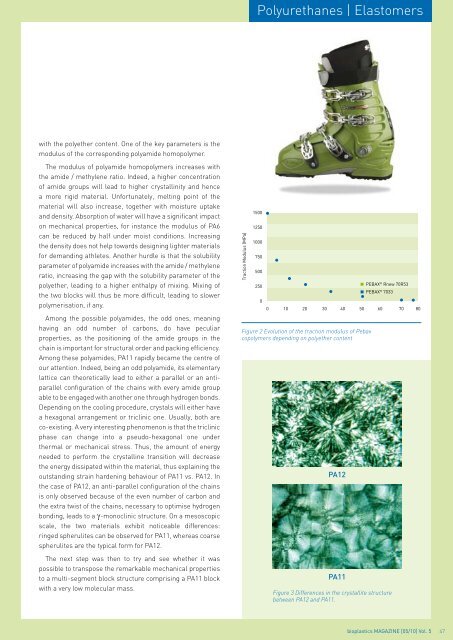05 | 2010
You also want an ePaper? Increase the reach of your titles
YUMPU automatically turns print PDFs into web optimized ePapers that Google loves.
Polyurethanes | Elastomers<br />
with the polyether content. One of the key parameters is the<br />
modulus of the corresponding polyamide homopolymer.<br />
The modulus of polyamide homopolymers increases with<br />
the amide / methylene ratio. Indeed, a higher concentration<br />
of amide groups will lead to higher crystallinity and hence<br />
a more rigid material. Unfortunately, melting point of the<br />
material will also increase, together with moisture uptake<br />
and density. Absorption of water will have a significant impact<br />
on mechanical properties, for instance the modulus of PA6<br />
can be reduced by half under moist conditions. Increasing<br />
the density does not help towards designing lighter materials<br />
for demanding athletes. Another hurdle is that the solubility<br />
parameter of polyamide increases with the amide / methylene<br />
ratio, increasing the gap with the solubility parameter of the<br />
polyether, leading to a higher enthalpy of mixing. Mixing of<br />
the two blocks will thus be more difficult, leading to slower<br />
polymerisation, if any.<br />
Among the possible polyamides, the odd ones, meaning<br />
having an odd number of carbons, do have peculiar<br />
properties, as the positioning of the amide groups in the<br />
chain is important for structural order and packing efficiency.<br />
Among these polyamides, PA11 rapidly became the centre of<br />
our attention. Indeed, being an odd polyamide, its elementary<br />
lattice can theoretically lead to either a parallel or an antiparallel<br />
configuration of the chains with every amide group<br />
able to be engaged with another one through hydrogen bonds.<br />
Depending on the cooling procedure, crystals will either have<br />
a hexagonal arrangement or triclinic one. Usually, both are<br />
co-existing. A very interesting phenomenon is that the triclinic<br />
phase can change into a pseudo-hexagonal one under<br />
thermal or mechanical stress. Thus, the amount of energy<br />
needed to perform the crystalline transition will decrease<br />
the energy dissipated within the material, thus explaining the<br />
outstanding strain hardening behaviour of PA11 vs. PA12. In<br />
the case of PA12, an anti-parallel configuration of the chains<br />
is only observed because of the even number of carbon and<br />
the extra twist of the chains, necessary to optimise hydrogen<br />
bonding, leads to a γ-monoclinic structure. On a mesoscopic<br />
scale, the two materials exhibit noticeable differences:<br />
ringed spherulites can be observed for PA11, whereas coarse<br />
spherulites are the typical form for PA12.<br />
The next step was then to try and see whether it was<br />
possible to transpose the remarkable mechanical properties<br />
to a multi-segment block structure comprising a PA11 block<br />
with a very low molecular mass.<br />
Traction Modulus (MPa)<br />
1500<br />
1250<br />
1000<br />
750<br />
500<br />
250<br />
0<br />
PEBAX ® Rnew 70R53<br />
PEBAX ® 7033<br />
0 10 20 30 40 50 60 70 80<br />
Figure 2 Evolution of the traction modulus of Pebax<br />
copolymers depending on polyether content<br />
PA12<br />
PA11<br />
Figure 3 Differences in the crystallite structure<br />
between PA12 and PA11.<br />
bioplastics MAGAZINE [<strong>05</strong>/10] Vol. 5 47


















